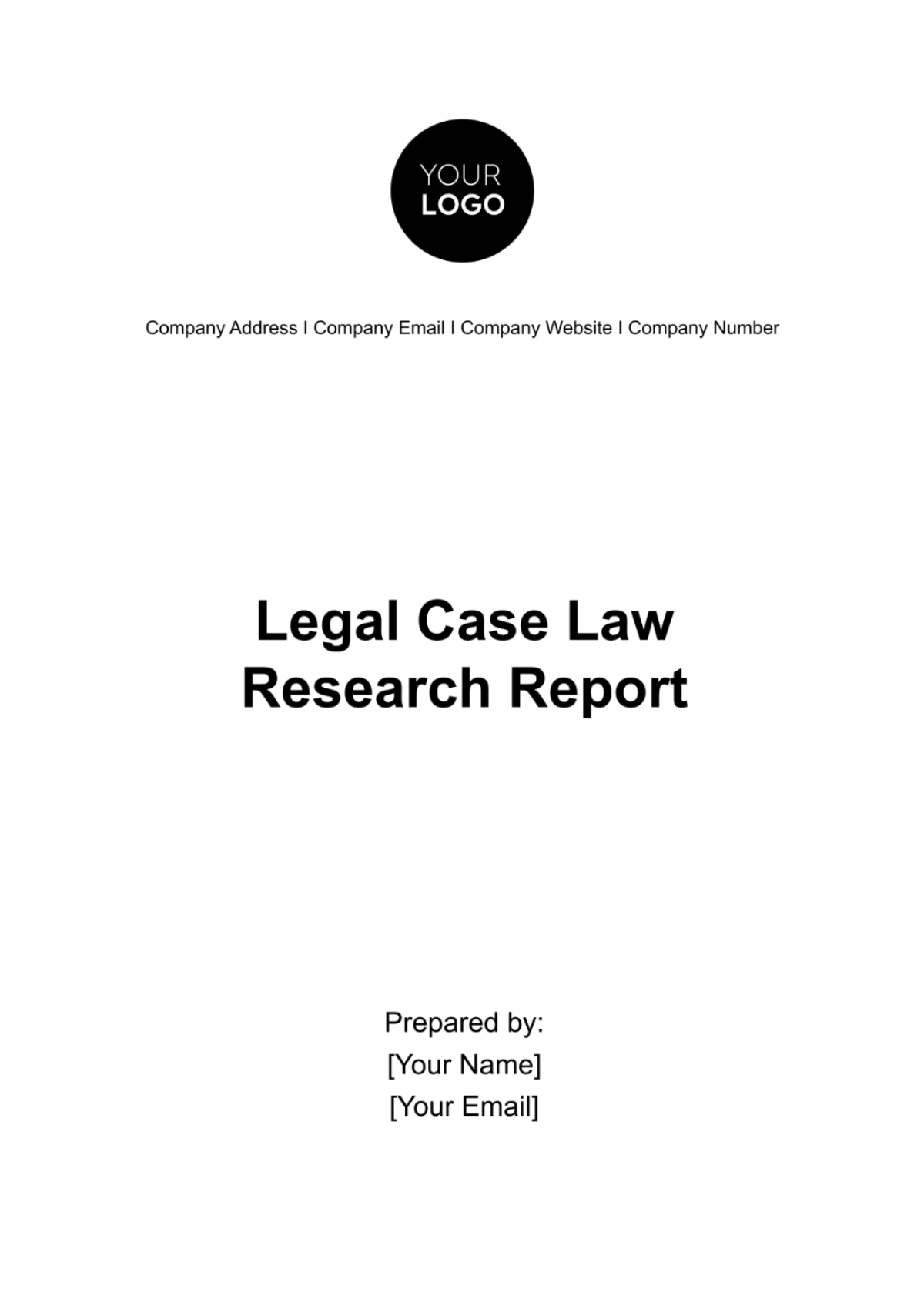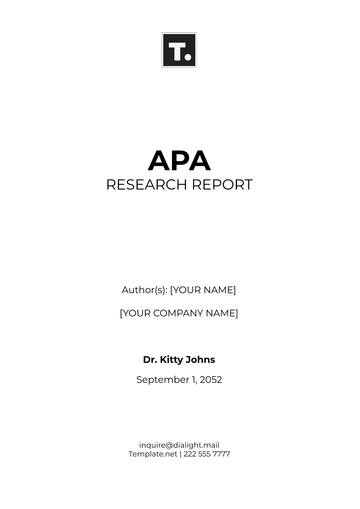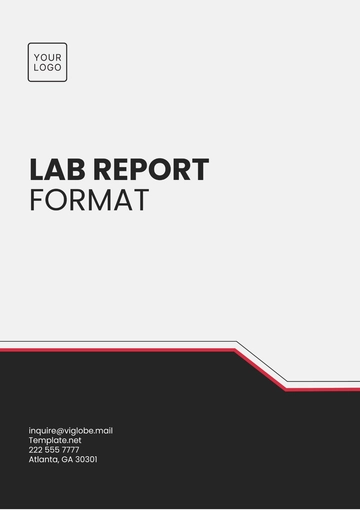Free Legal Case Law Research Report

I. Executive Summary
The legal case of [Smith v. Jones] is a notable instance of a contractual dispute with far-reaching implications. Originating from a real estate transaction gone awry, the case centers on the failure of one party to fulfill their contractual obligations within the agreed-upon timeframe. Despite attempts at resolution through mediation, the dispute escalated to litigation, culminating in a ruling by the Superior Court of [Your State]. The court's decision, favoring the plaintiff and mandating the defendant to fulfill their contractual duties, underscores the significance of contractual compliance and legal recourse in commercial transactions.
This report provides a comprehensive analysis of [Smith v. Jones] and its ramifications for [Your Company Name] and the wider industry. By examining the case background, legal intricacies, court proceedings, and eventual outcome, this report aims to equip [Your Company Name] with insights to navigate similar contractual disputes effectively. Furthermore, it offers strategic recommendations to mitigate legal risks and uphold contractual integrity in [Your Company Name]'s business operations.
II. Introduction
A. Background of the Case
The genesis of [Smith v. Jones] lies in a contractual agreement between [John Smith], the plaintiff, and [Sarah Jones], the defendant, pertaining to the sale of a residential property situated at [Property Address]. Executed on [Date], the contract stipulated that the defendant would transfer the property title to the plaintiff within [00] days of the contract's execution, in exchange for a predetermined sum of [$000,000].
Despite the clear terms outlined in the contract, the defendant failed to fulfill her obligations within the specified timeframe, prompting the plaintiff to assert a breach of contract. This failure precipitated a protracted dispute between the parties, marked by unsuccessful attempts at mediation and negotiation. Ultimately, the plaintiff resorted to legal action, filing a lawsuit against the defendant in the Superior Court of [Your State] to seek redress for the alleged breach.
B. Purpose of the Report
This report serves as a comprehensive examination of the legal case of [Smith v. Jones] and its implications for [Your Company Name]. By delving into the intricacies of the case, including its background, legal issues, court proceedings, and final adjudication, the report aims to provide [Your Company Name] with actionable insights into navigating contractual disputes and safeguarding its interests. Furthermore, it offers strategic recommendations to enhance [Your Company Name]'s contractual practices and mitigate the risks associated with similar disputes in the future.
III. Case Overview
A. Case Citation
Case Name: | [Smith v. Jones] |
Court: | Superior Court of [Your State] |
Case Number: | [Case Number] |
Date of Judgment: | [Date] |
B. Parties Involved
The parties involved in [Smith v. Jones] are as follows:
Plaintiff: [John Smith]
[John Smith] is the aggrieved party who initiated legal action against the defendant, [Sarah Jones], alleging breach of contract.
Defendant: [Sarah Jones]
[Sarah Jones] is the defendant accused of breaching the contractual agreement with the plaintiff, [John Smith].
C. Court Jurisdiction
The Superior Court of [Your State] holds jurisdiction over civil cases within its geographical boundaries, including contractual disputes and real estate matters. As such, it was the appropriate venue for adjudicating the case of [Smith v. Jones].
D. Case Timeline
The timeline of events in [Smith v. Jones] is as follows:
Event | Date |
|---|---|
Contract Execution | [Date] |
Deadline for Property Title Transfer | [Date] |
Plaintiff's Notification of Breach | [Date] |
Mediation Attempts | [Date] |
Filing of Lawsuit | [Date] |
Court Proceedings | [Date] |
Judgment | [Date] |
E. Legal Issues
The primary legal issue in [Smith v. Jones] revolves around the breach of contract, specifically concerning the failure of the defendant to transfer the property title to the plaintiff within the agreed-upon timeframe. Additional legal considerations may include contractual interpretation, remedies for breach, and potential defenses raised by the defendant.
IV. Legal Analysis
A. Relevant Laws and Regulations
The case is governed by various laws and regulations applicable to contracts, real estate transactions, and civil litigation within [Your State]. Key statutes and regulations that may apply include:
State Statute: This statute governs the formation, interpretation, and enforcement of contracts within [Your State].
State Real Property Law: This law regulates the transfer and ownership of real estate property, including the requirements for transferring property titles.
Civil Procedure Rules: These rules outline the procedural requirements and guidelines for civil litigation in the courts of [Your State].
B. Precedents and Case Law
Legal precedents and previous court decisions play a significant role in shaping the legal analysis of Smith v. Jones. Relevant case law may include:
[Johnson v. Smith]: This precedent addresses issues related to contractual performance and obligations.
[Jones v. Brown]: This case sets a precedent regarding the available remedies for breach of contract and the assessment of damages.
C. Arguments Presented
During the litigation process, both parties presented arguments to support their respective positions:
Plaintiff's Argument: The plaintiff argued that the defendant breached the contract by failing to transfer the property title within the specified timeframe. The plaintiff likely cited the contractual terms and the defendant's failure to comply with those terms as evidence of the breach.
Defendant's Argument: The defendant may have presented various defenses or mitigating factors to counter the plaintiff's claims. Possible arguments could include unforeseen circumstances, challenges in fulfilling the contractual obligations, or disputes over the interpretation of the contract terms.
D. Court's Decision
After carefully reviewing the evidence, arguments, and applicable law, the Superior Court of [Your State], presided over by [Judge Amanda Brown], rendered a judgment in favor of the plaintiff, [John Smith]. The court determined that the defendant, [Sarah Jones], had indeed breached the contract by failing to transfer the property title within the agreed-upon timeframe. As a remedy, the court ordered the defendant to fulfill her contractual obligations by transferring the property title to the plaintiff within a specified period, thereby resolving the dispute in favor of the plaintiff.
V. Impact Assessment
A. Implications on [Your Company Name]
The ramifications of [Smith v. Jones] for [Your Company Name] extend across various aspects of its operations:
Impact Area | Implications |
|---|---|
Contractual Compliance | The case underscores the paramount importance of adhering to contractual obligations meticulously. [Your Company Name] must institute robust processes to ensure strict compliance with contract terms, thereby mitigating the risk of potential disputes and legal entanglements. |
Risk Management | It serves as a stark reminder of the legal risks associated with contractual breaches. By meticulously analyzing the circumstances leading to the breach in [Smith v. Jones], [Your Company Name] can fortify its risk management strategies and proactively mitigate the potential financial and reputational fallout from similar scenarios. |
Legal Strategy | The court's ruling in [Smith v. Jones] furnishes invaluable insights into legal precedents and interpretations relevant to [Your Company Name]'s future legal strategy. Armed with this knowledge, [Your Company Name] can tailor its approach to contractual disputes and litigation, optimizing its chances of achieving favorable outcomes. |
B. Industry Implications
The repercussions of [Smith v. Jones] reverberate throughout the [industry] sector:
Impact Area | Implications |
|---|---|
Contractual Practices | The case serves as a salient reminder to all stakeholders in the [industry] sector of the criticality of meticulously drafting and scrutinizing contractual agreements. By ensuring the clarity, enforceability, and comprehensiveness of contractual provisions, industry participants can safeguard themselves against potential disputes and legal challenges. |
Legal Precedent Setting | The court's decision in [Smith v. Jones] may establish a precedent that significantly influences the interpretation and enforcement of contractual agreements within the [industry] sector. Consequently, industry stakeholders must monitor developments closely and adapt their contractual practices and risk management strategies accordingly to align with evolving legal standards. |
Compliance Standards | The ruling in [Smith v. Jones] necessitates a comprehensive review of compliance measures within the [industry] sector. Industry stakeholders must scrutinize existing protocols, policies, and practices to ensure alignment with the legal standards elucidated in the court's decision. By enhancing compliance standards, industry participants can mitigate legal risks and foster greater trust and confidence among stakeholders. |
C. Legal Precedent Setting
The legal precedent established by [Smith v. Jones] is poised to shape the trajectory of contractual disputes and litigation within the [Your State] jurisdiction:
Key Precedent | Implications |
|---|---|
Contractual Enforcement | The court's unequivocal enforcement of contractual agreements in [Smith v. Jones] underscores the judiciary's commitment to upholding contractual integrity. This precedent bolsters the confidence of contracting parties in the legal system's ability to safeguard their rights and enforce their obligations, fostering greater certainty and predictability in commercial transactions. |
Remedies for Breach | By delineating clear guidelines for assessing remedies in cases of contractual breaches, the court's ruling in [Smith v. Jones] equips contracting parties with valuable insights into the available legal recourses and the factors considered by courts in awarding remedies. This clarity facilitates informed decision-making and enables parties to pursue appropriate avenues for redress in the event of breaches. |
Judicial Interpretation | The court's interpretation of contract terms and legal principles in [Smith v. Jones] provides a roadmap for future judicial decisions and disputes involving analogous contractual provisions. This interpretation shapes the legal landscape by establishing norms and standards that influence the drafting, interpretation, and enforcement of contractual agreements within [Your State] jurisdiction. |
VI. Recommendations
A. [Your Company Name]'s Course of Action
To navigate the implications of [Smith v. Jones] effectively, [Your Company Name] should embark on the following course of action:
Conduct a comprehensive audit of existing contractual agreements, scrutinizing each provision to ensure clarity, enforceability, and compliance with legal standards.
Implement robust contract management systems and processes to monitor contract performance, track key deadlines, and facilitate timely intervention in the event of potential breaches.
Invest in ongoing training and capacity-building initiatives to enhance the contractual acumen and legal literacy of [Your Company Name]'s personnel, empowering them to negotiate, draft, and interpret contracts effectively.
B. Compliance Measures
To fortify its compliance framework and mitigate legal risks, [Your Company Name] should consider implementing the following measures:
Engage external legal counsel or consultants to conduct a comprehensive review of [Your Company Name]'s contractual practices, identifying areas of potential exposure and recommending remedial actions.
Establish robust internal controls and oversight mechanisms to ensure adherence to contractual obligations, with clear accountability and escalation protocols in place to address deviations promptly.
Foster a culture of compliance and ethical conduct across [Your Company Name]'s workforce through regular training sessions, awareness campaigns, and incentivization programs, reinforcing the importance of contractual integrity and legal compliance at all levels of the organization.
C. Mitigation Strategies
To proactively mitigate the potential impact of contractual disputes and legal challenges, [Your Company Name] should implement the following strategies:
Diversify its risk management portfolio by exploring alternative dispute resolution mechanisms, such as mediation and arbitration, as viable avenues for resolving contractual disputes expeditiously and cost-effectively.
Cultivate strategic partnerships with reputable legal service providers and litigation support firms, leveraging their expertise and resources to mount robust defenses and pursue favorable outcomes in the event of litigation.
Stay abreast of emerging legal trends, regulatory developments, and judicial precedents relevant to [Your Company Name]'s industry and operational landscape, adapting its contractual practices and risk mitigation strategies accordingly to anticipate and address evolving legal risks effectively.
- 100% Customizable, free editor
- Access 1 Million+ Templates, photo’s & graphics
- Download or share as a template
- Click and replace photos, graphics, text, backgrounds
- Resize, crop, AI write & more
- Access advanced editor
Efficiently conduct legal case law research with our Legal Case Law Research Report Template from Template.net. This customizable and editable document facilitates systematic analysis and documentation of case law findings. Tailored for legal professionals, it streamlines the process of synthesizing and presenting research outcomes. Editable in our Ai Editor Tool, adapt it to your specific requirements for thorough and insightful reports.
You may also like
- Sales Report
- Daily Report
- Project Report
- Business Report
- Weekly Report
- Incident Report
- Annual Report
- Report Layout
- Report Design
- Progress Report
- Marketing Report
- Company Report
- Monthly Report
- Audit Report
- Status Report
- School Report
- Reports Hr
- Management Report
- Project Status Report
- Handover Report
- Health And Safety Report
- Restaurant Report
- Construction Report
- Research Report
- Evaluation Report
- Investigation Report
- Employee Report
- Advertising Report
- Weekly Status Report
- Project Management Report
- Finance Report
- Service Report
- Technical Report
- Meeting Report
- Quarterly Report
- Inspection Report
- Medical Report
- Test Report
- Summary Report
- Inventory Report
- Valuation Report
- Operations Report
- Payroll Report
- Training Report
- Job Report
- Case Report
- Performance Report
- Board Report
- Internal Audit Report
- Student Report
- Monthly Management Report
- Small Business Report
- Accident Report
- Call Center Report
- Activity Report
- IT and Software Report
- Internship Report
- Visit Report
- Product Report
- Book Report
- Property Report
- Recruitment Report
- University Report
- Event Report
- SEO Report
- Conference Report
- Narrative Report
- Nursing Home Report
- Preschool Report
- Call Report
- Customer Report
- Employee Incident Report
- Accomplishment Report
- Social Media Report
- Work From Home Report
- Security Report
- Damage Report
- Quality Report
- Internal Report
- Nurse Report
- Real Estate Report
- Hotel Report
- Equipment Report
- Credit Report
- Field Report
- Non Profit Report
- Maintenance Report
- News Report
- Survey Report
- Executive Report
- Law Firm Report
- Advertising Agency Report
- Interior Design Report
- Travel Agency Report
- Stock Report
- Salon Report
- Bug Report
- Workplace Report
- Action Report
- Investor Report
- Cleaning Services Report
- Consulting Report
- Freelancer Report
- Site Visit Report
- Trip Report
- Classroom Observation Report
- Vehicle Report
- Final Report
- Software Report





























